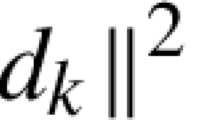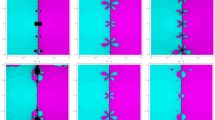Abstract
This work is dedicated to advancing the approximation of initial value problems through the introduction of an innovative and superior method inspired by Taylor’s approach. Specifically, we present an enhanced variant achieved by accelerating the expansion of the Obreschkoff formula. This results in a higher-order implicit corrected method that outperforms Taylor’s method in terms of accuracy. We derive an error bound for the Obreschkoff higher-order method, showcasing its stability, convergence, and greater efficiency compared to the conventional Taylor method. To substantiate our claims, numerical experiments are provided, which highlight the exceptional efficacy of our proposed method over the traditional Taylor method.








Similar content being viewed by others
Data availability
The data used to support the findings of this study are included in the article.
References
Abdeljawad, T., Amin, R., Shah, K., Al-Mdallal, Q., Jarad, F.: Efficient sustainable algorithm for numerical solutions of systems of fractional order differential equations by Haar wavelet collocation method. Alex. Eng. J. 59(4), 2391–2400 (2020)
Appell, P.: Sur une classe de polynômes. Ann. Sci. Ecole. Norm. Sup. 9(2), 119–144 (1880)
Borri, A., Carravetta, F., Palumbo, P.: Quadratized Taylor series methods for ODE numerical integration. Appl. Math. Comput. 458, 128237 (2023)
Amodio, P., Iavernaro, F., Mazzia, F., Mukhametzhanov, M.S., Sergeyev, Ya.D.: A generalized Taylor method of order three for the solution of initial value problems in standard and infinity floating-point arithmetic. Math. Comput. Simul. 141, 24–39 (2017)
Arefin, M.A., Gain, B., Karim, R.: Accuracy analysis on solution of initial value problems of ordinary differential equations for some numerical methods with different step sizes. Int. Ann. Sci. 10(1), 118–133 (2021)
Baeza, A., Boscarino, S., Mulet, P., Russo, G., Zorío, D.: Approximate Taylor methods for ODEs. Comput. Fluids 159, 156–166 (2017)
Baeza, A., Boscarino, S., Mulet, P., Russo, G., Zorío, D.: Reprint of: Approximate Taylor methods for ODEs. Comput. Fluids 169, 87–97 (2018)
Boas, R.P.: Generalized Taylor series, quadrature formulas, and a formula by Kronecker, short notes. SIAM Rev. 12(1), 116–119 (1970)
Alomari, M.W.: Two-point Ostrowski and Ostrowski–Grüss type inequalities with applications. J. Anal. 28(3), 623–661 (2020)
Alomari, M.W.: Two-point Ostrowski’s inequality. Results Math. 72(3), 1499–1523
Burden, R.L., Faires, J.D.: Numerical Analysis, 9th edn. Brooks/Cole, Cengage Learning, Boston (2011)
Carrillo, H., Macca, E., Parés, C., Russo, G., Zorío, D.: An order-adaptive compact approximation Taylor method for systems of conservation laws. J. Comput. Phys. 438(1), 110358 (2021)
Corliss, G.: Solving ordinary differential using Taylor series. ACM Trans. Math. Softw. 8(2), 114–144 (1983)
Dababneh, A., Zraiqat, A., Farah, A., Al-Zoubi, H., Abu Hammad, M.: Numerical methods for finding periodic solutions of ordinary differential equations with strong nonlinearity. J. Math. Comput. Sci. 11, 6910–6922 (2021)
Gadisa, G., Garoma, H.: Comparison of higher order Taylor’s method and Runge–Kutta methods for solving first order ordinary differential equations. J. Comput. Math. Sci. 8(1), 12–23 (2017)
Haq, F., Shah, K., Al-Mdallal, Q.M., Jarad, F.: Application of a hybrid method for systems of fractional order partial differential equations arising in the model of the one-dimensional Keller–Segel equation. Eur. Phys. J. Plus 134, 1–11 (2019)
Hummel, P.W., Seebeck, C.L.: A generalization of Taylor’s expansion. Am. Math. Mon. (MAA) 56(4), 243–247 (1949)
Jorba, Á., Zou, M.: A software package for the numerical integration of ODEs by means of high-order Taylor methods. Exp. Math. 14(1), 99–117 (2005)
Kythe, P.K., Schäferkotter, M.R.: Handbook of Computational Methods for Integration. Chapman & HallL/CRC, A CRC Press Company, London (2005)
Lakshminarasimhan, T.V.: On extensions of Taylor’s formula. Am. Math. Mon. 72(8), 877–881 (1965)
Matić, M., Pečarić, J., Ujević, N.: On new estimation of the remainder in generalized Taylor’s formula. Math. Inequal. Appl. 2(3), 343–361 (1999)
Ndam, J.: Comparison of the solution of the Van der Pol equation using the modified Adomian decomposition method and truncated Taylor series method. J. Niger. Soc. Phys. Sci. 2(2), 106–114 (2020)
Narayanan, K.L., Kavitha, J., Rani, R.U., Lyons, M.E., Rajendran, L.: Mathematical modelling of amperometric glucose biosensor based on immobilized enzymes: new approach of Taylor’s series method. Int. J. Electrochem. Sci. 17(10), 221064 (2022)
Obreschkoff, N.: Neue Quadraturtormeln. Abh. Preuss. Akad. Wiss. Math.-Nat. Kl. (4) (1940)
Qi, F., Luo, Q.-M., Guo, B.-N.: Darboux’s formula with integral remainder of functions with two independent variables. Appl. Math. Comput. 199, 691–703 (2008)
Robbins, H.: A remark on Stirling’s formula. Am. Math. Mon. 62(1), 26–29 (1955)
Shah, K., Abdeljawad, T., Ali, A., Alqudah, M.A.: Investigation of integral boundary value problem with impulsive behavior involving non-singular derivative. Fractals 30(8), 1–15 (2022)
Shah, K., Abdeljawad, T., Ali, A.: Mathematical analysis of the Cauchy type dynamical system under piecewise equations with Caputo fractional derivative. Chaos Solitons Fractals 161, 1–8 (2022)
Shah, K., Arfan, M., Ullah, A., Al-Mdallal, Q., Ansari, K.J., Abdeljawad, T.: Computational study on the dynamics of fractional order differential equations with applications. Chaos Solitons Fractals 157, 111955 (2022)
Wang, Z.X., Guo, D.R.: Special Functions, Translated from the Chinese by Guo and X. J. Xia. World Scientific, Teaneck (1989). https://doi.org/10.1142/0653
Wang, K., Wang, Q.: Taylor collocation method and convergence analysis for the Volterra–Fredholm integral equations. J. Comput. Appl. Math. 260, 294–300 (2014)
Whittaker, E.T., Watson, G.N.: A Course of Modern Analysis, 4th edn. Cambridge University Press, London (1940)
Author information
Authors and Affiliations
Corresponding author
Ethics declarations
Conflict of interest
The authors declare that they have no Conflict of interest.
Additional information
Publisher's Note
Springer Nature remains neutral with regard to jurisdictional claims in published maps and institutional affiliations.
Rights and permissions
Springer Nature or its licensor (e.g. a society or other partner) holds exclusive rights to this article under a publishing agreement with the author(s) or other rightsholder(s); author self-archiving of the accepted manuscript version of this article is solely governed by the terms of such publishing agreement and applicable law.
About this article
Cite this article
Alomari, M.W., Batiha, I.M. & Momani, S. New higher-order implict method for approximating solutions of the initial value problems. J. Appl. Math. Comput. (2024). https://doi.org/10.1007/s12190-024-02087-3
Received:
Revised:
Accepted:
Published:
DOI: https://doi.org/10.1007/s12190-024-02087-3




